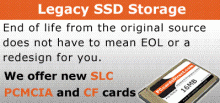Beyond the Bits: Choosing the Right NAND (SLC, MLC, TLC, QLC) for Harsh Environments
Selecting the right NAND flash type isn’t just a matter of speed or price—it’s about survival in the toughest environments. For industrial designers building systems that operate in high heat, vibration, or mission-critical settings, understanding NAND types is essential to balancing reliability, endurance, and cost.
This interactive guide provides a decision tree framework for selecting the appropriate NAND (SLC, pSLC, MLC, TLC, or QLC) based on environmental and workload requirements. It is tailored for embedded system designers, aerospace engineers, and industrial automation architects.
Overview: NAND Flash Types at a Glance
| NAND Type | Bits/Cell | Endurance (P/E Cycles) | Speed | Cost | Reliability |
|---|---|---|---|---|---|
| SLC | 1 | 50,000 – 100,000 | Fast | $$$ | Excellent |
| pSLC | 1 (emulated) | 20,000 – 50,000 | Fast | $$ | Very High |
| MLC | 2 | 3,000 – 10,000 | Medium | $$ | High |
| TLC | 3 | 1,000 – 3,000 | Medium | $ | Medium |
| QLC | 4 | <1,000 | Slower | $ | Low |
Interactive Decision Tree: Which NAND Should You Choose?
Step 1: What is your temperature range?
- -40°C to 85°C → Proceed to Step 2
- 0°C to 70°C → Proceed to Step 3
- 0°C to 50°C or office-controlled → TLC or QLC may be acceptable
Step 2: Is your application subject to shock or vibration?
- Yes → Prioritize SLC or pSLC
- No → Proceed to Step 4
Step 3: What is your workload type?
- High write intensity (e.g. logging, boot cycles, video capture) → Choose SLC or pSLC
- Moderate writes with high reads (e.g. boot drives, HMI) → Choose MLC or pSLC
- Read-heavy or archival (e.g. software image storage) → TLC or QLC acceptable
Step 4: Lifecycle expectations
- 5+ years in field → SLC, pSLC or high-endurance MLC
- 2-5 years → pSLC, MLC
- <2 years, consumer applications → TLC, QLC
Use Case Snapshots
1. Oil Rig Monitoring Systems
- Temperature: -30°C to 70°C
- Vibration: High
- Writes: Sensor logs every 10s
- Best NAND: SLC or pSLC
2. Digital Signage (Outdoor Transit Hub)
- Temperature: -20°C to 60°C
- Vibration: Low
- Writes: Moderate; content updates
- Best NAND: pSLC or MLC
3. Aerospace Flight Recorder
- Temperature: -55°C to 85°C
- Vibration: Extreme
- Writes: Constant logging
- Best NAND: SLC (certified)
4. Industrial PLC System
- Temperature: 0°C to 50°C
- Writes: Low; firmware updates only
- Reads: Moderate
- Best NAND: MLC or pSLC
Tips for Designers
- Always over-provision storage for wear leveling
- Use power-loss protection if logging critical data
- Validate NAND endurance against worst-case write workloads
- In regulated markets (e.g. aerospace), choose NAND with long-term supply roadmaps and certifications
- Self-destruct and error correction with wear leveling are also available in M.2 2280 SSDs from PCcardsDirect

Recent Comments
Archives
Categories
Meta
Search Menu
Recent Posts
Categories